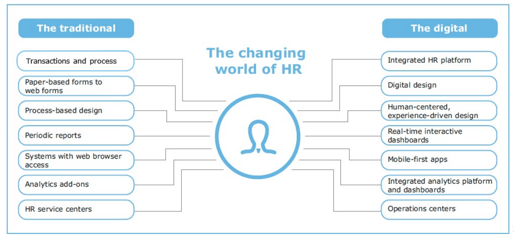The HR digital transformation has been one of the sector’s hottest topics over the last few years. A quick glance at this trend’s benefits makes it easy to justify the hype. Digital HR aims to squeeze every drop of potential out of this key area for business success and tends to lead to better decision making and results.
What is the HR digital transformation?
The digital transformation is the transition from a traditional, paper-based system to a model with technology at the heart of all internal and external functions. In a word: digitalisation.
This diagram from Deloitte shows the shift from the traditional model to digital HR:

Source: Deloitte
It is simultaneously a revolutionary process and an evolutionary phenomenon, involving a complete change of culture and mentality within the organisation, not just a new set of tools.
The HR department in particular has a steep slope to climb. This report by Deloitte highlights the fact that HR teams have to take on the “dual challenge of transforming HR operations on the one hand, and transforming the workforce and the way work is done on the other”.
In fact, throughout this process, the people are just as important as the technology. As this article from Forbes explains, the HR role is crucial. No other department has the capability to make sure the entire workforce receives the right information, and that professional development is aligned with the changes being introduced in the organisation.
Therefore, the digital transformation of HR does not just affect that department; its metamorphosis impacts the company as a whole. Or, at least, that’s the way it should be.
Why is the digital transformation so important?
The HR digital transformation is a key step which allows companies to:
- Automate processes and cut the time required for repetitive tasks.
- Optimise employee experience.
- Use the time that has been freed up to design strategies and improve business results.
It is important for all organisations to focus their efforts on these objectives. New technology must respond to the company’s specific needs, otherwise the expected results will simply not materialise, and the process may end in failure.
At the company Fleetpool, for example, they wanted to create a new style of working to enable them to streamline admin tasks. In this way, they were able to:
- Devote more time to strategic projects.
- Keep up with the growing workforce.
- Simplify the daily work routine.
How long does it take to go digital?
It’s important to understand that the digital transformation is a never-ending process. Technological advances and developments are continually emerging, so it is critical to remain open to change and keep evolving.
Experts also stress that the digital transformation does not happen overnight. Some companies hope it will happen within a year. However, for larger organisations it can take up to five. And even then, the task is never finished!
For HR, however, it does not need to take this long. When a company plans to digitalise the department, it can take as little as 30 days once the decision is approved to have the new tools in place. In fact, at Kenjo, we have managed to complete the software implementation in a single month for many companies.
HR digital transformation statistics
Various reports and studies have measured the impact of the HR digital transformation on companies. We’ve shared some of the interesting data we found below:
- 74% of companies planned to increase spending on HR tech in 2020 to address pressing talent needs (PwC).
- In the US, sales of HR and payroll software were expected to grow 8.7% in 2020 to reach $10.8 billion (IBISWorld).
- 81% of HR leaders are changing their performance management system (SelectHub).
- Companies that use e-learning technology achieve an 18% boost in employee engagement (SHIFT).
- 35% of HR managers think they don’t have the talent they need to carry out the digital transformation (Gartner shared by I-Scoop).
- Only 9% of professionals think that HR is leading or innovating in the context of new technology (PwC).
- 55% of professionals think that HR’s main contribution to the company’s transformation is the digitalisation of their own processes (PwC).

Challenges for the HR digital transformation
No one can say the digital transformation is an easy feat, whether we’re talking about the company in general or the HR department in particular. Employees who spearhead these efforts need to be aware of some significant challenges they are like to face.
- Creating a digital business culture: the business culture is key to the success of the digital transformation. HR should introduce measures to update it and make it more conducive to change. This can be done via training, conferences, etc.
- Unite management styles: in general it will be harder for experienced department managers to change the way they do things. And their whole team depends on them. It’s important to gain their support and ensure they feel confident with the new processes.
- Transforming HR processes: the department should lead by example, by digitalising their internal and external processes.
- Personalise employee and candidate experience: once automated tasks gain traction, it’s very easy for interactions to lose the human touch. We can preserve this by understanding our employees, anticipating their needs and personalising every detail.
The main players in the HR digital transformation
The success of the company’s and the HR department’s transformation depends on the whole organisation being involved and engaged. However, certain roles have responsibility for leading the change and setting the example. In general, the four central roles are:
- CEO: the leadership must be convinced of the benefits of making the leap to digitalisation for it to make headway throughout the organisation.
- HR Director: usually the driving force behind the transformation, or at least the person with the greatest responsibility. Their role is to plan the introduction of new tech and steer the required culture change.
- HR Manager: generally has a much more administrative, but no less important, role. They will be in charge of implementing new software, training colleagues, etc.
- External consultant: although this is an external role, the consultant can also play a key part in digitalisation. In fact, specialist consultants are often hired to lead the organisation’s or department’s digital transformation.
Steps to digitalise the HR department
What is the process for transforming to digital HR? Every company will sketch out their own route map depending on their starting point and individual objectives. However, we’ve put together the basic steps all companies will need to follow:
1. Set a clear goal
As always, before initiating any process of change it is essential to set a clear objective that fits the company’s circumstances. Earlier on we suggested three examples, but you may have others.
2. Generate as much support as possible
Approach as many people as you can, especially middle management and C-level executives. When we’re talking about digital transformation, we need all the help we can get.
3. Don’t complicate things
Start with simple and achievable goals. Research which areas of HR could easily become digital with the introduction of software and start from there. Talk with your team to get their opinions and decide what your priorities are.
4. Prioritise
Speaking of priorities, the digital transformation is a long process and occasionally the to-do list can seem endless. Prioritise actions in order of their impact and effort required (in terms of time and money). Start with high impact / low effort tasks to help kick start the transformation.
5. Evaluate the outcome
Trying out new tools and introducing changes can be exciting, but there is no point if we don’t evaluate the results. Review the analytics with a critical eye and identify what works and what doesn’t. This is the only way to solve problems, make progress and ensure the transformation works.



